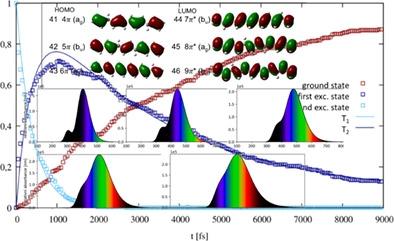当前位置:
X-MOL 学术
›
J. Comput. Chem.
›
论文详情
Our official English website, www.x-mol.net, welcomes your
feedback! (Note: you will need to create a separate account there.)
The vertical excitation energies and a lifetime of the two lowest singlet excited states of the conjugated polyenes from C2 to C22: Ab initio, DFT, and semiclassical MNDO-MD simulations
Journal of Computational Chemistry ( IF 3.4 ) Pub Date : 2022-11-29 , DOI: 10.1002/jcc.27040 Kateřina Fatková 1 , Radim Cajzl 1 , Jaroslav V Burda 1
Journal of Computational Chemistry ( IF 3.4 ) Pub Date : 2022-11-29 , DOI: 10.1002/jcc.27040 Kateřina Fatková 1 , Radim Cajzl 1 , Jaroslav V Burda 1
Affiliation

|
Electronic excited states in the series of polyene molecules were explored. Optimal ground-state geometry was used for the evaluation of vertical excitation energies. Results of a chosen set of functionals were compared to post-HF methods (EOM-CCSD, NEVPT2, CASPT2, and MRCI). In addition, the semiempirical OM2/MNDO method using MRCISD computational level was confronted with the above-mentioned techniques. Despite the fact that the first excited state has a significant double-excitation character some functionals were able to qualitatively determine the correct state order (where the lowest excited state has a character). The most successful functionals in transition energies predictions were PBE, TPSS and BLYP in Tamm-Dancoff approach (TDA), which had the smallest root-mean-square deviation (RMSD) scoring towards the experimental values. Regarding RMSD scoring, the OM2/MNDO method performed fairly well, too. Besides absorption spectra, lifetimes of the first two excited states were estimated based on a stochastic approach exploring a swarm of OM2/MNDO hopping dynamics using the Tully fewest switch algorithm for each molecule. The longest lifetime of the first excited state (S1) was found for decapentaene (about 5 ps). Further elongation of the conjugated chain caused a mild decrease of this value to ca 1.5 ps for docosaundecaene.
中文翻译:

从 C2 到 C22 的共轭多烯的两个最低单线态激发态的垂直激发能和寿命:从头算、DFT 和半经典 MNDO-MD 模拟
探索了多烯分子系列中的电子激发态。最佳基态几何用于评估垂直激发能量。将一组选定泛函的结果与 post-HF 方法(EOM-CCSD、NEVPT2、CASPT2 和 MRCI)进行了比较。此外,使用MRCISD计算级的半经验OM2/MNDO方法面临上述技术。尽管第一激发态具有显着的双激发特性,但一些泛函能够定性地确定正确的态序(其中最低激发态具有特点)。过渡能量预测中最成功的泛函是 Tamm-Dancoff 方法 (TDA) 中的 PBE、TPSS 和 BLYP,它们对实验值的均方根偏差 (RMSD) 得分最小。关于 RMSD 评分,OM2/MNDO 方法也表现得相当好。除了吸收光谱外,前两个激发态的寿命是基于随机方法估计的,该方法使用每个分子的 Tully 最少开关算法探索 OM2/MNDO 跳跃动力学群。第一激发态 (S 1 ) 的最长寿命被发现为癸戊二烯(约 5 ps)。对于二十二碳烯,共轭链的进一步延长导致该值轻微下降至约 1.5 ps。
更新日期:2022-11-29
中文翻译:

从 C2 到 C22 的共轭多烯的两个最低单线态激发态的垂直激发能和寿命:从头算、DFT 和半经典 MNDO-MD 模拟
探索了多烯分子系列中的电子激发态。最佳基态几何用于评估垂直激发能量。将一组选定泛函的结果与 post-HF 方法(EOM-CCSD、NEVPT2、CASPT2 和 MRCI)进行了比较。此外,使用MRCISD计算级的半经验OM2/MNDO方法面临上述技术。尽管第一激发态具有显着的双激发特性,但一些泛函能够定性地确定正确的态序(其中最低激发态具有特点)。过渡能量预测中最成功的泛函是 Tamm-Dancoff 方法 (TDA) 中的 PBE、TPSS 和 BLYP,它们对实验值的均方根偏差 (RMSD) 得分最小。关于 RMSD 评分,OM2/MNDO 方法也表现得相当好。除了吸收光谱外,前两个激发态的寿命是基于随机方法估计的,该方法使用每个分子的 Tully 最少开关算法探索 OM2/MNDO 跳跃动力学群。第一激发态 (S 1 ) 的最长寿命被发现为癸戊二烯(约 5 ps)。对于二十二碳烯,共轭链的进一步延长导致该值轻微下降至约 1.5 ps。











































 京公网安备 11010802027423号
京公网安备 11010802027423号